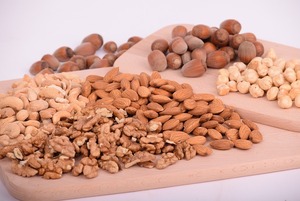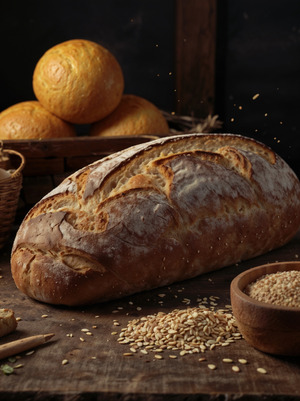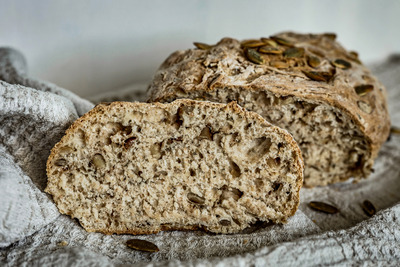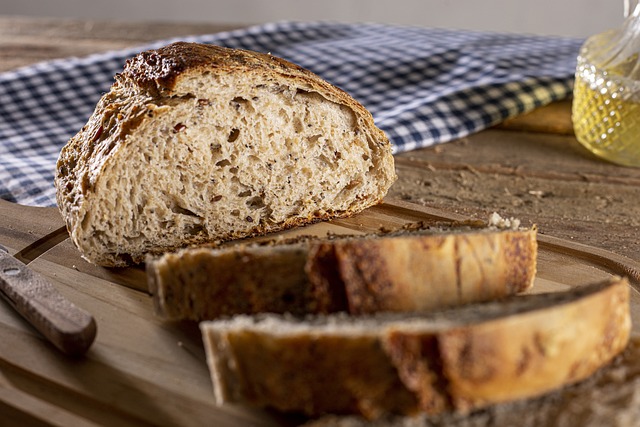What is Sourdough Bread with Seeds and Nuts?
Sourdough bread with seeds and nuts is a flavorful and nutritious variation of traditional sourdough bread. Sourdough itself is made using natural fermentation with wild yeast and lactobacilli, giving it a tangy taste and chewy texture. By incorporating seeds like flax, sunflower, and sesame, along with nuts such as almonds and walnuts, the bread becomes more flavorful, nutritious, and texturally interesting.
Why Add Seeds and Nuts?
- Enhanced flavor: Seeds and nuts add a rich, earthy, and sometimes sweet flavor.
- Texture: The crunchy addition of seeds and nuts provides contrast to the chewy crumb of sourdough.
- Nutritional value: Seeds and nuts boost the bread’s protein, fiber, healthy fats, and vitamins.
A Brief History of Sourdough Bread with Seeds and Nuts
The tradition of sourdough bread dates back thousands of years, but adding seeds and nuts is a more recent trend. This twist has become popular as more people have recognized the health benefits of whole grains, seeds, and nuts. Today, it’s a favorite among home bakers and health-conscious consumers.
- Ancient sourdough: Originating around 3700 BC, sourdough is one of the oldest forms of leavened bread.
- Modern innovations: The addition of seeds and nuts has gained popularity due to their health benefits and texture-enhancing qualities.
Nutritional Benefits of Adding Seeds and Nuts to Sourdough Bread
Incorporating seeds and nuts into sourdough bread isn’t just about taste—it also significantly improves its nutritional profile. Here’s why adding these ingredients is beneficial:
Nutrients from Seeds

Seeds are nutrient-dense and provide a range of essential vitamins, minerals, and healthy fats. Here are some of the most popular seeds added to sourdough:
- Flaxseeds:
- Rich in omega-3 fatty acids, which support heart health.
- High in fiber, aiding in digestion.
- Sunflower Seeds:
- Packed with vitamin E, a powerful antioxidant.
- Contains magnesium and selenium, supporting heart health.
- Sesame Seeds:
- High in calcium and magnesium, supporting bone health.
- Rich in antioxidants, reducing inflammation.
- Pumpkin Seeds:
- High in zinc, which supports immune health.
- Contains magnesium, promoting heart and bone health.
Health Benefits of Nuts in Bread
Nuts, like seeds, offer various health benefits, making sourdough even more nutritious. Here are some commonly used nuts and their benefits:

- Almonds:
- Rich in vitamin E and healthy fats.
- Support skin and heart health.
- Walnuts:
- High in omega-3 fatty acids.
- Reduces inflammation and supports brain health.
- Hazelnuts:
- Full of antioxidants.
- Supports heart health and helps lower cholesterol.
- Pecans:
- Rich in fiber, aiding digestion.
- High in antioxidants, promoting cellular health.
Fiber, Protein, and Heart Health
Adding seeds and nuts to sourdough bread not only enhances flavor but also increases the content of fiber, protein, and heart-healthy fats. These nutrients help:
- Improve digestion: The fiber content keeps the digestive system moving smoothly.
- Boost satiety: Protein and fiber help you feel fuller longer.
- Promote heart health: Healthy fats from nuts and seeds contribute to better cardiovascular function.
How to Choose the Best Seeds and Nuts for Your Sourdough
Choosing the right seeds and nuts for your sourdough can make a big difference in texture, flavor, and nutrition. Let’s explore how to pick the best ones.
Best Seeds to Use in Sourdough Bread
Different seeds offer different flavors and textures. Here are some excellent options:
- Sunflower Seeds: Mild, nutty flavor with a satisfying crunch.
- Pumpkin Seeds: Sweet and chewy, adding moisture to the dough.
- Sesame Seeds: Small and toasty, perfect for a subtle flavor boost.
- Flaxseeds: Best used ground, offering a slight nuttiness and lots of fiber.
- Chia Seeds: Absorb water and gel, adding moisture and fiber to the bread.
Choosing the Right Nuts
Nuts not only provide flavor but also influence the bread’s texture. Here are some popular choices:
- Almonds: Crunchy with a sweet, slightly bitter flavor.
- Walnuts: Rich and earthy, complementing the sourness of the dough.
- Pecans: Buttery with a softer texture, great for sweeter bread.
- Hazelnuts: Sweet and nutty, offering both crunch and a rich flavor.
Combining Seeds and Nuts for Optimal Texture
Combining seeds and nuts can create a well-balanced loaf of sourdough. Consider these tips:
- 2:1 ratio: Use two parts seeds to one part nuts for balanced texture.
- Mix small and large seeds: Combining smaller seeds like sesame with larger ones like pumpkin creates layers of texture.
- Chunky nuts: Keep nuts in larger chunks to add crunch without overwhelming the bread.
Step-by-Step Guide to Making Sourdough Bread with Seeds and Nuts

Ingredients You’ll Need
To make the perfect sourdough bread with seeds and nuts, gather these ingredients:
Basic Sourdough Ingredients
- Flour: Typically bread flour or a mix of whole wheat and bread flour.
- Water: Filtered water works best to avoid any interference with fermentation.
- Sourdough Starter: The natural yeast and bacteria that give sourdough its rise and flavor.
Additional Ingredients
- Seeds: Flax, sunflower, sesame, chia, or pumpkin.
- Nuts: Almonds, walnuts, pecans, or hazelnuts.
- Optional Add-ins: Spices like cinnamon or sweeteners like honey for extra flavor.
Mixing and Preparing the Dough
Activating the Starter
Before you start baking, make sure your sourdough starter is fully active. Follow these steps:
- Feed your starter: Mix equal parts flour and water into your starter at least 4-6 hours before baking.
- Check for bubbles: A well-fed starter will be bubbly and airy, indicating it’s ready to use.
- Smell test: The starter should have a pleasant, tangy smell, not overly acidic or off-putting.
Incorporating Seeds and Nuts
To achieve the best flavor and texture, add seeds and nuts at the right stage in the dough preparation process:
- After mixing the dough: Once your dough is well-mixed and rested, gently fold in the seeds and nuts.
- Don’t overdo it: Too many seeds and nuts can affect the dough’s ability to rise. Use around 20% of the dough’s total weight in seeds and nuts.
- Even distribution: Make sure to evenly distribute seeds and nuts throughout the dough for consistent bites.
The Fermentation Process
Primary and Secondary Fermentation
The fermentation process is crucial to developing sourdough’s unique flavor and texture. Here’s what you need to know:
- Bulk fermentation: After mixing in seeds and nuts, let the dough ferment for 3-5 hours, depending on room temperature.
- Shaping and proofing: After the initial rise, shape your dough and let it undergo a second rise (proof) for 1-2 hours, or overnight in the fridge for deeper flavor.
Adjusting Fermentation Time for Seeds and Nuts
Seeds and nuts can slightly slow down fermentation due to their added density, so keep an eye on the dough. Here are a few tips:
- Shorten proofing time: If you notice the dough becoming too dense, reduce the second fermentation by 30 minutes.
- Room temperature: Make sure the dough is fermenting at a consistent room temperature (ideally 70-75°F).
Creative Add-Ins for Sourdough Bread with Seeds and Nuts

Sourdough bread with seeds and nuts is already a delicious and nutritious loaf, but you can elevate its flavors and textures with some creative variations. Adding unique ingredients such as spices, dried fruits, and experimenting with different types of grains can enhance both the taste and the nutritional value of your bread. This section explores several exciting ways to add variety to your sourdough.
Flavor Variations
Introducing new flavors can transform your sourdough into a personalized masterpiece. Spices and dried fruits are among the most popular additions, offering a range of sweet and savory notes.
- Spices: Adding spices like cinnamon and cardamom can give your sourdough a warm, aromatic flavor. Cinnamon pairs beautifully with nuts and seeds, especially in sweeter breads, while cardamom adds a subtle citrusy and spicy touch.
- Dried Fruits: Incorporate dried fruits like raisins, cranberries, or chopped dates for a burst of natural sweetness. These fruits not only enhance the flavor but also add moisture to the bread, making it more tender.
These add-ins create a delightful contrast with the tangy base of sourdough, making each slice rich in flavor. The sweetness of the fruit and the warmth of the spices complement the nutty crunch of the seeds and nuts.
Gluten-Free and Low-Carb Options
If you or your family members have dietary restrictions, sourdough bread can still be adjusted to meet those needs without sacrificing flavor or texture. Gluten-free and low-carb variations are popular choices for health-conscious bakers.
- Gluten-Free Sourdough: You can create gluten-free sourdough by using a combination of gluten-free flours, such as rice, buckwheat, or almond flour. Seeds and nuts can add texture and nutrition, making up for the lack of gluten in the bread.
- Low-Carb Variations: For those following a low-carb or ketogenic diet, using almond flour or coconut flour in place of traditional wheat flour can significantly reduce the carbohydrate content of your bread. Seeds like chia and flaxseeds are excellent for adding fiber while maintaining a low-carb profile.
These options allow everyone to enjoy sourdough bread, regardless of dietary preferences or restrictions. With a few adjustments, you can create a loaf that’s both delicious and diet-friendly.
Whole Grain and Multigrain Sourdough Variants
For a more nutritious and heartier loaf, you can explore whole grain and multigrain variations of sourdough. These types of bread are packed with fiber, vitamins, and minerals, making them a healthy addition to your diet.
- Whole Grain Flours: Try using whole wheat, spelt, or rye flour in your sourdough recipe. These flours add a deep, earthy flavor and improve the nutritional profile of the bread. Whole grains also contribute to a denser, more satisfying crumb.
- Multigrain Mix: You can experiment by combining different grains like oats, barley, millet, and quinoa into the dough. These grains add texture and a rustic flavor, as well as provide an extra dose of fiber and nutrients.
Using whole grains and multigrain blends gives your bread a unique, hearty texture and adds a nutty flavor that pairs perfectly with the seeds and nuts. It’s a great way to boost the health benefits of your homemade bread.
Common Mistakes and How to Avoid Them
Dough Consistency
One of the most common mistakes when adding seeds and nuts to sourdough is not adjusting the hydration. Seeds tend to absorb water, which can dry out the dough if not accounted for.
- Tip: Slightly increase the water content when adding seeds and nuts to ensure your dough remains soft and elastic.
Overproofing
Overproofing happens when the dough rises too much, leading to a flat, deflated loaf. Seeds and nuts add extra weight to the dough, making it more prone to overproofing.
- Tip: Keep an eye on the dough during fermentation. Use the “poke test”—if the dough springs back slowly, it’s ready to bake.
Achieving a Perfect Crust
Seeds on the exterior of the bread can burn if baked at too high a temperature, especially in the case of small seeds like sesame or flax.
- Tip: Use a covered Dutch oven or bake with steam for the first part of baking to prevent burning. Uncover the bread in the last 10-15 minutes for a golden, crispy crust.
Enjoy Your Homemade Sourdough Bread with Seeds and Nuts
Sourdough bread with seeds and nuts is a perfect combination of flavor, texture, and nutrition. The versatility of the dough allows you to experiment with various seeds, nuts, and creative add-ins, such as spices and dried fruits. By making small adjustments, like using whole grains or opting for gluten-free or low-carb versions, you can tailor the bread to your preferences and dietary needs.
This homemade bread is a wonderful way to enjoy the benefits of natural fermentation and the nutritional boost from seeds and nuts. Don’t hesitate to try different combinations of add-ins to create the perfect loaf that suits your taste. With practice and creativity, you’ll soon master the art of making delicious sourdough bread!
Tips & Notes for Sourdough Bread with Seeds and Nuts
| Tip or Note | Details |
|---|---|
| How long does sourdough bread with seeds and nuts last? | Sourdough bread can last 4-5 days when stored properly in a bread box or wrapped in cloth. For longer storage, freeze it in airtight containers. |
| Can you add seeds to any sourdough recipe? | Yes, seeds can be added to most sourdough recipes. Adjust hydration if needed to prevent the dough from drying out. |
| Best way to store sourdough bread with seeds? | Store in a cool, dry place in a breathable material like a towel or bread box. Avoid plastic bags to maintain crust texture. |
| How to make sourdough bread more flavorful? | Extend fermentation time or add herbs, spices, or sweeteners. Toasting seeds before adding them also enhances flavor. |
| Best seeds for sourdough bread | Sunflower, flax, pumpkin, sesame, and chia seeds are popular choices. They add flavor, crunch, and boost nutrition. |

